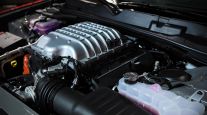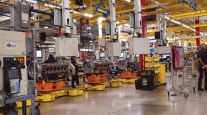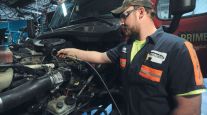OEMs Mixed on Turbo Compounding
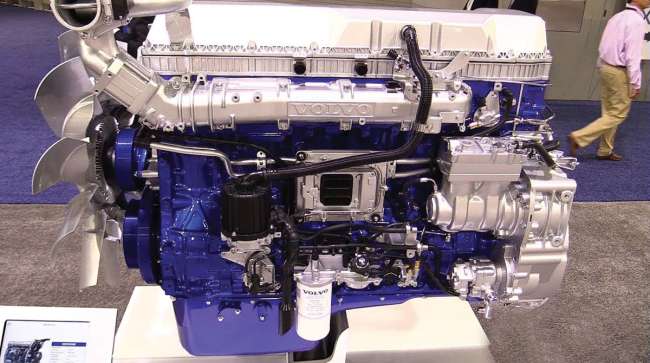
Volvo Trucks North America says its D13TC engine’s turbo compounding unit will add 50 horsepower through waste heat recovery and will improve fuel efficiency by 7.5%. The company believes the technology could reach the same level of market acceptance as its automated transmissions. But not every manufacturer believes turbo compounding is the best way to improve fuel efficiency.
John Moore, Volvo Trucks’ product marketing manager for powertrain, told Equipment & Maintenance Update that the turbo compounding unit will raise the engine’s brake thermal efficiency — the amount of energy produced by a gallon of diesel to power the wheels — from 43% to 48%. It does this by capturing energy that would have been lost in the stack or the cooling system and feeding it back into the engine.
It is the equivalent of a truck having 1.5 turbochargers, according to Moore. “It’s like a push from behind,” he said.
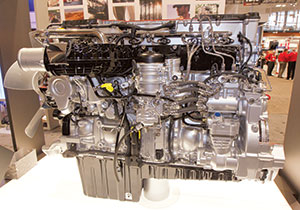
A Detroit DD15 engine on display at a 2016 truck show. (John Sommers II for Transport Topics)
The engine was introduced as part of Volvo’s 2017 greenhouse gas standards-compliant powertrain. The technology is designed to meet the expected 1.2 million-mile life of the engine without requiring extra maintenance, Volvo said.
Fleets can expect a payback within the first year of operation, Moore said. The technol-ogy eventually could achieve the same level of 90% market acceptance that automated transmissions eventually reached among the company’s customers, he said. But, that won’t happen immediately.
“It’s something different, and this industry, it’s slow to change,” Moore said. “So any time you introduce anything new to any product, people kind of take a back stance and look at it from afar. So we have to do our due diligence to show that this is a premium product.”
And what about the other OEMs?
Mack Trucks, which like Volvo Trucks is a brand within the Volvo Group, announced last year that turbo compounding would be available with its 2017 MP engines. Its recently announced Mack MP8HE engine uses Mack Energy Recovery Technology, its turbo compounder. The turbo compounder combined with features such as aerodynamic improvements included in the Mack HE+ package enables Mack Anthem models to improve fuel efficiency by up to 9.5% and qualify for the U.S. Environmental Protection Agency’s SmartWay designation.
Detroit uses turbo compounding in its DD16 engine, its largest, to generate up to about 192 pound-feet of torque for Freightliner and Western Star Trucks. Detroit, Freightliner and Western Star are part of Daimler Trucks North America.
But Detroit has moved away from turbo compounding in its DD15 engines, which did have the technology prior to the 2014 GHG regulations. According to Brian Daniels, manager of Detroit powertrain and component product marketing, that engine’s 2014 update left out turbo compounding and instead relied on its proprietary Detroit Asymmetric Turbocharger, which he said is a simplified, more efficient and more durable design that is 70 pounds lighter.

Moore
The engine’s turbine housing includes two different-sized scrolls that separate exhaust gas routing for higher recirculation and reduced nitrogen oxide emissions, Daniels said. Fuel efficiency is improved through other features, including its variable-speed water pump, piston design and downspeeding.
According to Volvo Trucks, the biggest improvement with turbo compounding occurs in longhaul applications that are downsped, a growing segment that now includes a third of the company’s on-highway sales. With those packages, the torque band is 37% wider, allowing trucks to achieve peak torque at 900 rpm instead of 1,000 and continuing that range up to 1,300 rpm.
Across that wide a range, the driver will notice better performance because the truck won’t downshift as often, and it will save fuel, Moore said. The engine will run in 11th gear between 50 and 60 mph. “Our challenge is to create an engine that’s super fuel-efficient yet drives well because it’s two factors there,” he said. “You have to have happy drivers, and you have to have happy owners.”
Jack Legler, technical director for American Trucking Associations’ Technology & Maintenance Council, said turbo compounding can be especially effective for fleets that are downspeeding and that the maintenance shouldn’t be too much of a headache. “All you’re doing is boosting on top of boosting on top of boosting,” he said.
According to Volvo Trucks’ Moore, waste heat recovery systems such as turbo compounding will be one way truck manufacturers improve fuel efficiency. One potential is using a Rankine cycle system where a fluid would be used to capture some of the energy in a closed system.
“The future, everybody’s going to have new technology, and that means different things,” Moore said. “We don’t know exactly what everybody’s going to use, but chances are it’ll be some sort of recovery system to try to take advantage of that wasted heat.”
“We feel we’ll be very well positioned in the future with this engine,” Moore said.
However, Jim Nachtman, Navistar’s marketing director, heavy-duty product segment, said the company doesn’t have plans to add a turbo compounder to its line of International trucks. Nachtman said manufacturers must ensure new technologies don’t add to a fleet’s maintenance issues, thereby negating any fuel economy gains they offer.
“If you add a lot of complexity to a vehicle, there’s a higher propensity for something to fail, and when a fleet tells us that a day of downtime is worth $1,000 to $1,500 per day depending on the fleet, plus the cost of the repair itself, if you save a small amount of fuel economy but incur some extra downtime, in general that is not advantageous to the customer’s bottom line,” Nachtman said.
Instead, Navistar intends to continue improving the turbocharger itself, which it sees as a better option. Its turbocharger will look the same, but the geometry will be a little different in order to promote more efficient air flow. The manufacturer is concentrating on other ways to improve engine efficiency — by moving to a low-friction ring pack, low-friction piston skirt coatings and a slower water pump speed, for example. Changing from an 11-blade fan blade to a six-blade version has freed an additional 31 horsepower, while predictive cruise control can improve fuel economy by 1% to 2%.
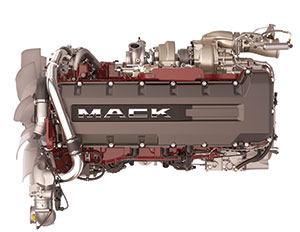
The Mack MP8HE engine that uses turbo compounding technology. (Mack)
Nachtman said International increased fuel economy 4% to 5% in the 2016-17 model year and increased it 9% with last year’s A26 engine in its LT series in comparison with its N13.
“Essentially there’s a limitless number of ways that you can improve fuel economy, and one of our jobs is to find ways that basically deliver the highest return on investment for the customer,” Nachtman said. “We try to come up with the technologies that will give best-in-class fuel economy while retaining the likely easy to service and outstanding uptime characteristics that are required.”
Technologies sometimes fail to take root for one reason or another. Legler said he had expected liquefied natural gas to gain a foothold in the U.S. market, but the storage challenges and costs were too prohibitive.
Among the other manufacturers, engine maker Cummins does not include turbo compounding in its original equipment specs, the company said.
The widespread adoption of turbo compounding will depend on whether the fuel economy gains will justify the various costs, including research costs, Legler said. “Fleets aren’t going to buy anything that doesn’t put something on the bottom line that has a positive, or significant, ROI that’s bigger than their other opportunity costs,” he said.
Changes are being driven by market demand as well as future federal GHG regulations affecting trucks in 2021, 2024 and 2027. Of the two, market demand is the more powerful, Legler said. “Freight shippers aren’t going to pay for green just because it’s green,” he said. “They’re going to pay for it because it keeps their shipping costs down unless there’s a cost associated on the other side of it.”
Paccar, which makes Peterbilt and Kenworth trucks, declined to comment for this story.


